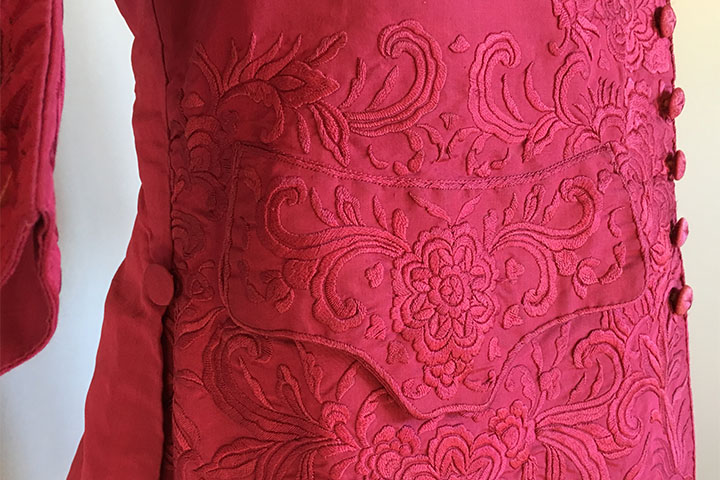
SOLD
Rare Chinese Export Waistcoat
1740s
Chinese embroidered garments made for the Western export market are rare. This type of top quality embroidery was done in Suzhou but exported through Canton (Guangzhou). In 1753 it was decreed as the only port permitted to conduct overseas business. This region produced fine workmanship, top quality and more expensive pieces. The pattern for the embroidered decoration, would have been drawn in ink onto the uncut lengths of the silk taffeta. In a few places you can see traces of the ink under the embroidery. The silk was then embroidered in Chinese twisted silks. The uncut waistcoat lengths would have been shipped to Britain, via the East India Company, where they would have been made up by a mantua maker. This type of garment would have been very expensive in the West.
I have often wondered why the Chinese only used twisted silk thread on export embroideries whilst using floss silks for their own use. An embroidery friend tells me that twisted silks are cheaper to produce, more durable, easier to use and need less experience to embroider than floss silks. This would also mean that the Chinese could produce embroideries for the Western market more quickly and therefore cheaper. Most embroidery came either through the ports of Canton, or Macau for the Portuguese market, but would have been embroidered all over China.
Cataloguing
Of crimson silk taffeta, the round curving neck with embroidery from the shoulder seam widening down the front (4 in; 10 cm) with the sides of the waistcoat filled with embroidery, with exotic stylised pomegranates, flowers and leaves, thirteen silk embroidered buttons and buttonholes, the later embroidered in crimson silk, the lower two in yellow/beige the gently shaped pocket also embroidered, opening to reveal silk and cotton lining, the three quarter sleeves with underarm gussets, a gentle outer curve with embroidered embroidery cuffs, side vents caught with a silk covered button, the back of similar plain silk taffeta, back vent, lined with natural coloured cotton to the top half and sleeves, the lower sleeves lined with crimson silk.
Back of neck to hem 34 in; 87 cm
Underarm 38-40 in; 97 - 1m
Condition
Very very good. There is slight underarm soiling as you will see from photos but this hardly shows. You may be wondering about the lower two buttonholes which have been left a different colour. Often these two were not buttoned up and sometimes have not been slit, but still sewn. Interestingly the other buttonholes have this same colour under the crimson silk. We can only assume that they were not finished perhaps as a fashion statement.
You will notice the side vents have the plainer back panel overlapping the embroidered front panel. We think that perhaps at a slightly later date, when coats were narrower, the waistcoat skirts were altered to fit under a slimmer line coat. Clearly this was a much admired waistcoat and the owner continued to wear it when it would not have been quite so fashionable.
Comments
Los Angeles County Museum have a sleeved waistcoat from the 1740s similarly embroidered in blue, for the export market.
https://www.pinterest.com/pin/173247916886160547/
1740.http://collections.lacma.org/node/214509
Bertin-Guest, Josiane Chinese Embroidery. Traditional Techniques.
For similar see my website. 18th century Dress and then look in the Sold section and you will see a yellow sleeveless waistcoat.
